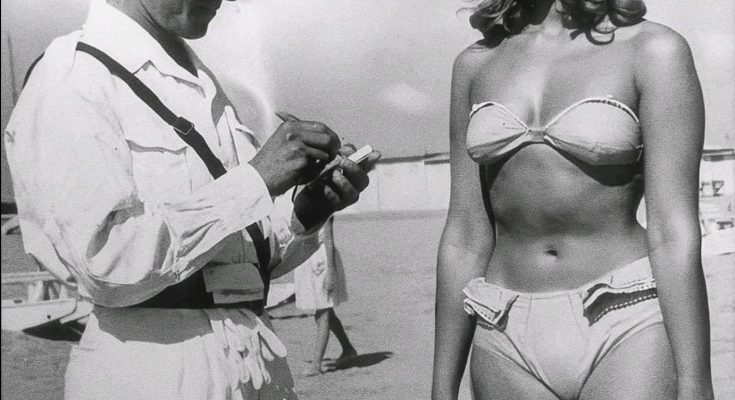
Just one small piece of clothing. That’s all it took to create anger, bans, and even arrests all over the world.
In the long battle between being modest and having freedom, the bikini became both a bad guy and a winner. Popes said it was wrong. Governments made it illegal.
But women continued to wear it — and with each daring appearance, they changed the game.
Tailors on the beaches
At the beginning of the 20th century, swimsuits were nothing like the cool, stylish ones we see today. Back then, they were big, full-body suits made from wool, meant to keep swimmers covered and safe from the sun. This wasn’t about looking good — it was about being modest.
Strict dress codes were everywhere at beaches in the U.S. According to Kathleen Morgan Drowne and Patrick Huber in their book about 1920s pop culture, places like Chicago’s Clarendon Beach even hired tailors to make quick fixes to swimsuits that were considered too revealing.
Similar rules appeared all over the country — for instance, Coney Island banned bathing socks in 1915 if they showed “dimpled knees.” In Washington, DC, beach police were known to check these rules with tape measures in hand.
Arrested for a one-piece?
In the early 1900s, people were all about hiding their bodies. Both men and women had to wear suits that covered them from neck to knee — there were no exceptions. If anyone showed any skin? That was seen as really scandalous.
But things were about to change. In 1907, an Australian swimmer named Annette Kellerman was one of the first to break these rules when she wore a one-piece swimsuit that showed her arms, legs, and neck, instead of the long pantaloons that were popular at the time.
Kellerman, who was called “the Australian Mermaid” because she was such a great swimmer, spent a lot of her life pushing against society’s rules and changing what people thought was acceptable.
According to Kellerman herself, she was taken by the police for wearing her “indecent” outfit, but there are no official reports to back this up. Still, it created a big scandal back then for a woman to swim like that. The event made news and started a movement.
Kellerman’s bold choice of swimwear caught everyone’s eye, and soon, her one-piece suits became a trendy thing.
The demand grew so much that she eventually started her own swimwear line, and the “Annette Kellermans,” as they were called, were the first step towards the development of modern women’s swimwear.
The roaring ‘20s: A new wave of fashion
As the 1920s continued, the flapper style began to make a splash, not just in evening dresses, but also at the beach.
It all began when a group of rebels from California stood up against tradition. They were known as the “skirts be hanged girls,” and their simple goal was to create swimsuits that women could actually swim in.
So, swimwear started to change, becoming more practical and fitting. The “skirts be hanged girls” represented a nationwide change that was about more than just style — it was about being functional and free to move.
While it was still modest compared to today, women were gradually showing more skin, with swimsuits made for freedom of movement. But the real revolution was still on the way.
The bikini: A scandalous step forward
In 1946, the bikini was born. It was created by a French engineer named Louis Réard, and this two-piece swimsuit showed off the belly button and revealed more skin than people thought was okay for public places.
Just a few days before the bikini was launched in 1946, the U.S. did its first nuclear test during peacetime at Bikini Atoll, which got a lot of attention worldwide.
Even though Louis Réard, the designer, never said why he chose the name “bikini” for the swimsuit, many think it was because he wanted it to have a big impact, like an explosion, both in sales and in culture, similar to the bomb itself. Some people believe the name was inspired by the exotic nature of the Pacific or that it compared the surprise of a revealing swimsuit to the force of an atomic explosion.

The response in the U.S. was quick: many beaches decided to ban the bikini, and it was viewed as really rebellious. Things were not much better in Europe either. In 1949, France made bikinis illegal on its beaches, and in Germany, they were not allowed in public pools until the 1970s. At the same time, some communist groups criticized the bikini as a symbol of capitalist excess and moral decay.
Pope Pius XII called the bikini sinful, and several countries — including Belgium, Italy, Portugal, and Spain – put nationwide bans on the swimsuit.
In a famous incident in 1952, Australian model Ann Ferguson was told to leave the beach at Surfers Paradise because her Paula Stafford bikini was seen as too revealing.
The truth about the famous photo
One picture has become a symbol of the whole debate about whether bikinis should be allowed on public beaches or not. This photo is from Italy.
The black-and-white picture, which has become popular online in recent years, shows a man in a white uniform standing next to a young woman in a bikini on a beach. People on social media often say this moment was taken in Rimini, Italy, in 1957. The most shared version of the story claims that the man is a police officer giving the woman a ticket just for wearing a bikini.
A Reddit post from 2023 that featured this image got over 31,000 upvotes and 1,400 comments. Its caption said: ‘A police officer gives a ticket to a woman for wearing a bikini, 1957.’
But was it real?
The picture is real — there’s no evidence of any digital editing — but the story behind it is still unknown. There’s no strong evidence that the woman was given a ticket for her swimwear. Some people think it might have been a fake scene with models or actors, while others think the officer could have been giving her a ticket for a totally different reason.
Still, the picture struck a chord.
In an email, Gianluca Braschi, who is the director of the State Archives of Rimini, told Snopes that Italy did have laws about swimwear back then, even if the story behind the picture is still a mystery.
As Braschi pointed out, a law from 1932 prohibited “bathing in public view in a state of complete nudity and with indecent swimwear.” This law technically stayed in effect until 2000, although it wasn’t always enforced.
So, while we might never find out the complete story behind that famous moment, it shows a real conflict from that time, when bikinis didn’t just attract attention… they could also land you in trouble.
The Hollywood effect
It wasn’t until the 1960s that the bikini really took off. Changes in culture allowed for bolder swimwear styles.
But even then, people had mixed feelings. More traditional areas resisted the tiny two-piece.
One example is the United States Motion Picture Production Code — commonly known as the Hays Code — which started being enforced in 1934. While it allowed two-piece swimsuits in movies, it strictly prohibited showing the belly button. To add to the pressure, the National Legion of Decency, a Roman Catholic group, urged Hollywood and filmmakers around the world to keep bikinis off the big screen completely.
The rise of Hollywood stars like Marilyn Monroe, Ursula Andress, and Brigitte Bardot helped change the ideas of beauty and body confidence. These stars didn’t just wear swimsuits — they became known for them.
The Girl in the Bikini
Maybe no one did more to make the bikini famous worldwide than the French actress Brigitte Bardot.
It wasn’t only that she wore a bikini; it was the way she completely embraced it. In her breakout role in The Girl in the Bikini, Bardot didn’t just put on the swimsuit; she transformed it into a cultural icon. Her figure, snugly fitted into a strapless, diamond-shaped bikini top that seemed like it could pop off at any moment, was the star of the movie.
With her long, messy hair and a relaxed vibe, Bardot wasn’t just performing — she was changing how women could be portrayed in films.
The movie made sure to capture her enjoying the ocean and the sun, but let’s be real: it was her body that the camera loved. The film showcased her in classic pin-up style, but Bardot wasn’t just a pretty face; she became the first actress to make a bikini the focus of a leading role and give it a story of its own.

Although she wasn’t the first woman to wear a bikini, Bardot was the one who made it famous through storytelling, and the effect of that film in the U.S. shot her to instant international fame.
Ursula Andress’s white bikini from Dr. No (1962) quickly became a symbol because it mixed sexiness, strength, and cinematic impact in a way that audiences had never seen before.
When she came out of the ocean with a knife on her hip, Andress was more than just eye candy — she was strong, confident, and unforgettable. That moment made her the ultimate Bond girl and established the bikini as a sign of bold femininity in pop culture.
By the 1970s, bikinis were everywhere. Swimsuits became even more revealing, with string bikinis and thong-style bottoms making their debut. Men’s swim trunks also got shorter, as the “modesty” of the early 20th century faded away.
Swimsuits today: Body positivity and diversity
Jumping to the 21st century, swimwear is no longer just about following societal rules. The swimwear market has exploded into a world full of choices.
From modest one-pieces to string bikinis and daring thongs, there’s something for everyone. Plus, the conversation about body types has changed a lot. Nowadays, it’s about comfort, confidence, and body positivity, with people of all shapes, sizes, and backgrounds expressing themselves freely at the beach or pool.
The days of regulating “decent” swimwear are gone. Now, it’s all about personal choice and self-expression. Whether it’s a full-coverage swimsuit or the most revealing bikini, America’s changing views on modesty show a much more inclusive and accepting society.
What began as a fight for modesty has turned into a celebration of diversity, individuality, and freedom. So the next time you go to the beach, remember: it’s not just about the swimsuit — it’s about the journey to self-expression that it represents.









